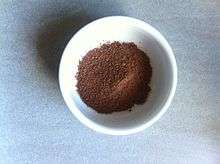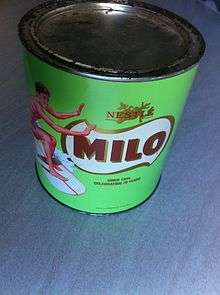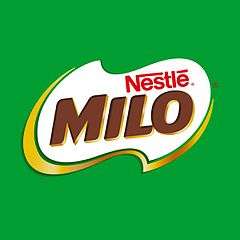Milo (drink)
|
Milo's logo | |
| Product type | Hot cocoa |
|---|---|
| Owner | Nestlé |
| Country | Australia |
| Introduced | 1934 |
| Markets | Worldwide, mostly Australia, New Zealand, Asia, South Africa, Nigeria and Latin America |
| Website |
www |
Milo /ˈmaɪloʊ/ is a chocolate and malt powder that is mixed with hot or cold water or milk to produce a beverage popular in many parts of the world. Produced by Nestlé, Milo was originally developed by Thomas Mayne in Sydney, Australia, in 1934.[1] It is marketed and sold in many countries around the world.
Most commonly sold as a powder in a green tin, often depicting various sporting activities, Milo is available as a premixed beverage in some countries, and has been subsequently developed into a snack bar and breakfast cereal. Its composition and taste differ in some countries.
History

In 1934, Australian industrial chemist and inventor Thomas Mayne developed Milo and launched it at the Sydney Royal Easter Show.[2] Milo began production at the plant located in Smithtown, near Kempsey on the North Coast of New South Wales. The name was derived from the famous ancient athlete Milo of Croton, after his legendary strength.[3]
Manufacture

Milo is manufactured by evaporating the water content from a thick syrup at reduced pressure. The thick opaque syrup is obtained from malted wheat or barley. The whole process takes around an hour but operates in a continuous mode. At the bottom of the box the varying sized chunks of soft solid, from fist size to fine powder, fall from the last conveyor into an airlock where they are brought back to atmospheric pressure. The solid is introduced into a hammer mill where it is broken up into the final granular form. The hygroscopic granular powder is packaged by filling cans from the "bottom", because the "top" end has been previously fabricated with an aluminium foil seal beneath the lid. The cans then have the tinplate bottoms affixed by a roll seam and the paper label is applied to complete the product. Some other chocolate drink bases, such as Ovaltine, are made by similar processes.
Consumption


Milo is added to hot or cold water and/or milk to make a malted chocolate beverage. It does not dissolve readily in cold milk, and so retains the gritty texture of its raw state. Milo can be stirred into steamed milk to make a drink akin to hot chocolate or cocoa. Another possible use is making a normal cup of cold Milo and microwaving it for approximately 40–60 seconds. This gives the Milo drink a biscuity cover on top. Use of very hot water when making a Milo drink can also alter the taste somewhat as will re-heating a made-up drink which has gone cold.
Milo is sometimes sprinkled on ice cream or breakfast cereals. Milo is often the favoured beverage for the Tim Tam Slam.[4]
Also very popular is the "Magic Milo" which involves adding Milo to a small amount of milk with sugar and whipping it to increase the amount of air in the milk, thereby doubling it in size. Then one adds small amounts of hot water and milk in layers stirring each new layer vigorously to maintain its lightness. A final layer of whipped cream is then topped with extra Milo or chocolate sprinkles. This is more of a 'warm' beverage rather than a 'hot' one and is a more popular version of hot Milo for children.
Milo manufactured outside Australia is customised for local methods of preparation. In Malaysia and Singapore, Milo with ice added is known as "Milo Ice" (alternatively, "ping" or "peng", meaning ice in Cantonese and Hokkien respectively). Iced milo is even available at fast food restaurants such as KFC and McDonald's.[5][6][7] Milo is also served locally in kopitiams and mamak stalls in versions such as "Milo Dinosaur" (a cup of Milo with an extra spoonful of powdered undissolved Milo added to it), "Milo Godzilla" (a cup of Milo with ice cream and/or topped with whipped cream) and "Neslo" (combined with Nescafé powdered coffee). The Milo powder is also usually used in the making of Batik cake. In Hong Kong, Milo is served in Cha chaan teng.
Milo is also a famous beverage in Indian Muslim stalls, or fondly known as Mamak stalls in Malaysia. It is also sometimes used as an alternative to jam and spread on bread or also as an ingredient in Roti Canai, and is usually called "Roti Milo".[8]
In the Caribbean, Milo is a popular hot beverage analogous to tea or coffee. It is also sold in a popular juicebox size and served cold.
Marketing



In Australia and most other countries, the packaging is green and depicts people playing various sports on the tin. A higher malt content form also existed in Australia and was marketed in a brown coloured tin which was usually only available in the 375g size. As of May 2015 this form is no longer manufactured. An organisation called MILO in2CRICKET, which operates in most areas by volunteers, teaches girls and boys the skills of the game.
Milo's commercials and taglines are "Go and go and go with Milo". A recent Australian commercial incorporating this slogan depicts four generations of women on a skipping rope singing "and my mum gave me Milo to go and go and go." The tag "I need my Milo Today" is also used. The packaging of tins of Milo in Malaysia and Singapore are also green and also have people playing sports on the tins, giving it the affectionate name of "Tak Kiu", Hokkien Chinese for "kick ball". In Colombia, Milo is closely tied to football (soccer), and the slogan several generations have sung is Milo te da energía, la meta la pones tú ("Milo gives you the energy, you set the goal").
Milo is very popular in Malaysia and Singapore, where the brand name is synonymous with chocolate flavoured drinks: Milo has a 90% market share in Malaysia (not the often quoted 90% worldwide share of Milo consumption),[9] and Malaysians were said to be the world's largest consumers of Milo.[10] This is because Milo was once used as a nutrient supplement when it was first introduced in the country, and has thus gained a reputation as a 'must have' drink for the old and the younger generations. Milo manufactured in Malaysia is made to dissolve well in hot water to produce a smooth hot chocolate drink, or with ice added for a cold drink. "Milo Vans" were often associated with sports days in these two countries, during which primary school pupils would queue up to collect their cups of Milo drinks using coupons.
In Peru, during the 1970s military dictatorship, Milo labels displayed Peruvian motifs, such as photos and pictures of Peruvian towns, history, crops, fruits, animals, plants,[11][12] as an educational aid. After 1980, when the military left power, sports predominated on the labels.
The Indian version is no longer in production because of intense competition from other beverages.
Nestlé has now introduced a Canadian version of Milo. It is made in Canada. It dissolves rapidly like Nesquik, probably due to market expectations, but still retains the malt flavour. It is also sweeter than other varieties. This Milo as the brand has been in Eastern Canada since the late 1970s with the influx of people from previous British colonial territories such as the Caribbean and Hong Kong, and India. It was available in mostly small ethnic grocery stores, especially Caribbean food stores. It has recently been selling at larger chains to beef up their share in the ethnic market in Canada, and is now available in places like Superstore, Extra Foods and London Drugs. Some East Asian supermarkets (such as T&T Supermarket in Edmonton, Vancouver, Toronto and Calgary) will carry the version imported from China or Hong Kong.
Aside from the International section of specific grocery stores and certain Asian grocery stores, Nestlé does not market Milo in the United States.
It can also be found in the UK in some Sainsbury's and Tesco supermarkets, which import it from Kenya and South Africa. Asian food specialists, such as Mini Siam Oriental Foods and Hoo Hing also stock it. A similar product called Ovaltine is most popular with UK consumers.
In Ireland, Milo can be found in many Asian or African stores. Typically they will stock Kenyan or Filipino Milo.
In China, Milo is commonly sold in western supermarkets, but also smaller convenience stores. Usually packaged in a 240gram flexible foil pouch, single drink packets can also be purchased. The Milo itself contains more milk solids than the Australian Milo, and so it is not necessary to add milk before consumption.
In the past Milo was available in Portugal and in Brazil. Nestlé Brazil discontinued production of Milo in Brazil to focus on the much-popular domestic brands Nescau and Nesquik. The Chilean version of Milo is still in production and is identical in taste and texture to the one that was once produced in Brazil.
In May 2013, and after more than 20 years out of the Portuguese market, Nestlé reintroduced the brand aiming at the high-end market.[13]
Nutritional information
Milo contains 1,680 kJ (402 calories) in every 100 g of the powder, mostly from carbohydrates, mainly sugar. Carbohydrates can be used for energy by the body, which is the basis of Milo being marketed as an energy drink.
Milo dissolved in water has a Glycemic Index (GI) of 55, the same as Coca-Cola.[14] However, milk has a much lower GI of 30 - 33, so mixing a very small amount of Milo into a mug of milk yields an overall GI closer to 33, and mixing a large amount of Milo into a mug of milk will give a GI closer to 55.
The Milo website states that the drink is high in calcium, iron and the vitamins B1, B2, B6, B12. Milo is advertised as containing "Actigen-E", but this is just Nestlé's trademarked name for the vitamins in the Milo recipe.[15]
Milo contains some theobromine, a xanthine alkaloid similar to caffeine which is present in the cocoa used in the product.[16][17]
Derivative products

Products based on Milo are available, such as cereal, yoghurt and ice cream. In addition to the powdered form, there is a pre-mixed version of Milo that comes in cans or drink boxes.
Milo has been made into a chocolate bar, manufactured by Nestlé and sold in New Zealand, Australia, Malaysia, Indonesia, Singapore, Thailand and South Africa.
Milo has been available for many years in a malted flavour, marketed in a brown can (discontinued in Australia in May 2015) alongside the traditional green tin.
In Australia, a new version of Milo called Milo B-Smart was released in 2008 (the original and malt Milo varieties remain); which is of a finer texture and has added B vitamins and iodine. It has a different taste from the original Milo formula and is marketed as a health food for children.[18]
Nestlé Philippines released Milo R2, a Milo drink formulated for athletes and working adults. In Japan, Milo is marketed as a canned energy drink, available in vending machines.
In some regions, a Milo branded cereal is produced. It consists of a crunchy crescent moon-shaped flake of dark brown colour. These flakes are flavoured to match Nestlé's Milo powdered drink. The flakes also have the property of flavouring the milk. In Asia, Milo cereal is shaped into crunchy balls about 0.5" in diameter. This is to contrast with an existing cereal also shaped like a hollow half moon marketed as Koko Krunch.
See also
References
- ↑ http://www.milo.com.my/about
- ↑ http://www.milo.com.au/about/
- ↑ http://www.milo.com.au/about
- ↑ "How to Perform a Tim Tam Slam". Instructable. Retrieved 1 February 2015.
- ↑ "Nutrition Information: Desserts & Beverages". Kentucky Fried Chicken. Retrieved 10 November 2016.
- ↑ "Nutrition Information: Beverages". McDonald's. Retrieved 15 August 2013.
- ↑ Archived 19 March 2013 at the Wayback Machine.
- ↑ "Food Tour Malaysia". Trip Advisor. Retrieved 17 April 2015.
- ↑ Nestlé: Our transformational opportunity
- ↑ Jaya, Petaling (24 February 2009). "Shahrir urges restaurants to lower price of Milo". The Star Online. Retrieved 15 August 2013.
- ↑ Arkivperu (5 August 2013). ""Zoología botánica" de Milo (1973) |". Arkivperu.com. Retrieved 11 September 2013.
- ↑ ""Zoología botánica" de Milo (1973)". Arkivperu. 2 December 2007. Retrieved 9 August 2013.
- ↑ http://www.nestle.pt/SaboreiaaVida/Noticias/Pages/MILOregressa20anosdepois.aspx
- ↑ "Glycemic Index for Milo (Nestlé, Australia) dissolved in water". Diet & Fitness Today. Retrieved 15 August 2013.
- ↑ "What is Actigen-E?". Milkpowder is too Danger. 22 July 2008. Retrieved 15 August 2013.
- ↑ "Caffeine and theobromine levels in selected Nigerian beverages.". BioMedSearch. Retrieved 1 February 2015.
- ↑ William Gervase Clarence-Smith (2000). Cocoa and Chocolate, 1765–1914. London: Routledge. pp. 10, 31. ISBN 0-415-21576-5.
- ↑ "Nestlé Urges Kids to B-Smart". Can and Aerosol News. 13 August 2008. Retrieved 12 November 2016.
External links
| Wikimedia Commons has media related to Milo (drink). |

